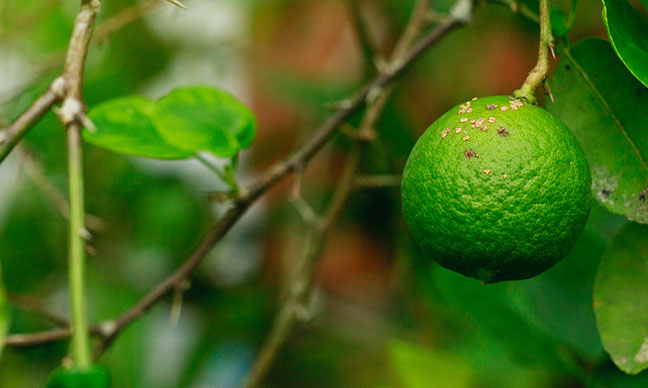Since the 1870s, the citrus industry has been expanding rapidly in California. Today, there are more than 270,000 acres of citrus-bearing land in the state. Not to mention, it is also a common choice for a garden crop. If you are growing one, then you should be concerned about huanglongbing, a significant California citrus threat.
Like other crops, citrus in California isn’t spared from pests and diseases. While there are many potential problems, in this article, the spotlight is on huanglongbing.
What is Huanglongbing – A California Citrus Threat
Also called citrus greening disease, yellow dragon disease, and yellow shoot disease, huanglongbing devastates the global citrus industry, not just in California. It has a worldwide impact on the size and shape of citrus production. All commercial citrus varieties and cultivars are affected by the disease.
The disease spreads through a tiny insect – citrus psyllid. The global movement of citrus crops contributes to its transmission. It is not harmful to humans and animals, but once it infests trees, the effects are devastating.
Psyllids, whether African or Asian, are small and flying insects with an average length of 3 to 4mm. They are smaller than the South American palm weevil, making detection more difficult. They penetrate the sap tissue of the plant and suck the nutrients essential for its health.
Signs and Symptoms to Watch Out For
One of the earliest signs of the citrus tree disease is evident on the leaves. New infections leave a blotch mottled appearance on the surface of the leaves. In cases of chronic infections, the leaves are significantly smaller and will have asymmetrical molting.
The disease significantly compromises the quality of the fruit, making it a problem amongst commercial producers. The fruits are small, lopsided, and poorly colored. It will also have aborted seeds. Even when the fruit matures, it retains the green color of its navel. Because of the small size and poor quality, the fruit will have no commercial value.
While the initial symptoms include only loss of vigor, eventually, the host plant will die. The younger the citrus tree is, the quicker it will die as a result of infestation.
How to Treat Huanglongbing
Unfortunately, there is no known treatment for this citrus tree disease. It results in the death of its host plant unless preventive measures were undertaken. As the infestation becomes more severe, in most instances, the only option is tree removal California. This will prevent the infection and pests from spreading to healthy trees.
The treatment options available are for getting rid of psyllid but not for reversing the damages that are already present. To control the population of the disease-carrying pests, one of the best things to do is to use foliar pyrethroid insecticide. It kills both adult and immature psyllids, preventing them from wreaking havoc in citrus trees. The soil application of an insecticide can also help manage the population of psyllids.
Using organic and soft foliar insecticides can also help, especially at homes. Neem oil, for instance, is effective and safe in the beneficial insects that are possibly present in the area. These measures, however, are best only for small-scale applications and not in commercial orchards.
Effective Measures for Prevention
Providers of tree services California recommend a robust proactive approach to prevent huanglongbing. Prevention is better than cure when dealing with this citrus tree disease. Below are some of the best things to do:
- Thorough inspection is one of the best ways to prevent the disease from spreading. Check the leaves, especially the new clusters forming. From nymphs to waxy deposits, pay attention to signs of damage to determine if the tree needs to be removed to prevent the disease from spreading.
- Biological controls are also promising. Parasitic wasps and predators, including lady beetle, can help control the population of nymphs that cause the disease. Take note, this is to control the pest but not the disease.
- Consulting with the concerned authorities is also a must. Among others, the USDA Cooperative Extension Service is one that can help in effectively addressing the problem.
- Buy citrus plants to grow only from certified vendors. This way, you can have an assurance of its safety, minimizing the possibility of disease transmission. The product should comply with the existing rules and regulations.
- If you grow citrus plants, know what the law says regarding its movement. If you live in a quarantine area, then this means that you cannot move the plants. Even the leaves and foliage can contribute to disease transmission, so make sure to follow the quarantine protocols.
- Local officials may also recommend and administer insect traps. Your full cooperation is important to make these measures succeed.
- Be responsible when it comes to the disposal of leaves, twigs, and other parts of the tree. Otherwise, this can trigger the transmission of the disease to healthy plants and other potential hosts.
- Lack of knowledge and awareness is one of the leading causes of the continuous infestation of the citrus greening disease. Invest in your knowledge. Read and learn about the problem for better detection and management.
FAQs
Q: What does citrus greening disease look like?
A: The appearance of the citrus greening disease depends on the part it affects. On the fruit itself, citrus is small and poorly colored with aborted seeds. The leaves, meanwhile, will have asymmetrical blotches.
Q: What does citrus quarantine mean?
A: A citrus quarantine is a government-mandated program that prevents the movement of nursery stocks and plant materials out of a specified area. Only commercially cleaned and packed citrus fruits can leave the quarantine area, which will prevent the spread of the citrus tree disease.
Q: How is citrus treated?
A: The most common citrus treatment includes spraying insecticides to control some of the most serious pests and diseases. It is often done early on to prevent the infestation from spreading.
Local Tree Experts Overview
In sum, huanglongbing is the most significant California citrus threat today! Spread by psyllids, it affects the commercial and economic value of citrus. To date, there is no known treatment for this disease, so the best thing that you can do is to engage in preventive measures to limit its devastation.




